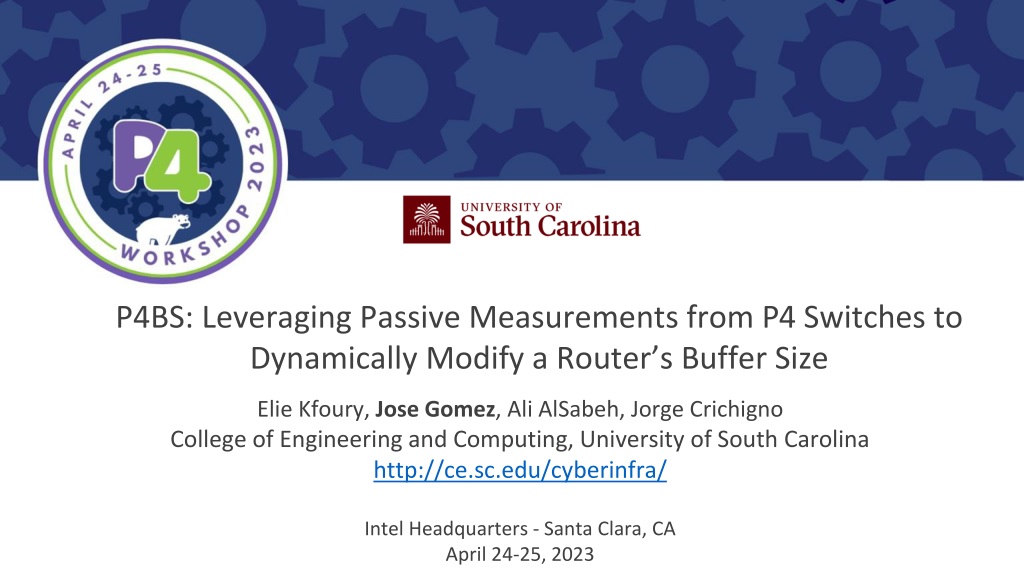

Replay
0 likes | 11 Views
This research presents a system that leverages passive measurements from P4 switches to dynamically adjust a router's buffer size for optimizing network performance. By computing factors like long flows, round-trip times, queue delays, and packet losses, the system dynamically searches for an optimal buffer size to minimize delays and losses. Through extensive evaluation with different network scenarios and congestion algorithms, the system shows promising results in balancing flow completion times and improving network efficiency.

E N D
P4BS: Leveraging Passive Measurements from P4 Switches to Dynamically Modify a Router’s Buffer Size Elie Kfoury, Jose Gomez, Ali AlSabeh, Jorge Crichigno College of Engineering and Computing, University of South Carolina http://ce.sc.edu/cyberinfra/ Intel Headquarters - Santa Clara, CA April 24-25, 2023
Introduction • The size of a router’s buffer has implications on the network performance • Large buffer excessive delays • Small buffer packet losses, low link utilization • How big should the buffer be? 2
Static Buffer Rules • Bandwidth-delay product Buffer = C * RTT C is the capacity of the port and RTT is the average round-trip time • Stanford rule: Buffer =? ∗ ??? √? N is the number of long (persistent over time) flows traversing the port • Operator hardcodes the buffer size based on typical traffic 3
Proposed System • The buffer size is dynamically modified • A P4 switch is deployed passively to compute: Number of long flows Average RTT Queueing delays Packet loss rates • The control plane sequentially searches for a buffer that minimizes delays and losses • The searching algorithm Optimization (BO) with Gaussian Processes is Bayesian 4
Evaluation • 1000 senders • P4 switch: Wedge100BF-32X with Intel’s Tofino ASIC • Legacy router: Juniper router MX-204 • Different congestion algorithms • Access network: control C1= 40Gbps, C2= 1Gbps • Core network: C1= 10Gbps, C2= 2.5Gbps 5
Results • Combined metric accounting for packet loss and delay [0, 1] (the lower, the better) • Top heatmaps: access network • Bottom heatmaps: core network • The Mixed scenario combines multiple congestion control algorithms1 1 Mishra et al. “The great Internet TCP congestion control census,” ACM on Measurement and Analysis of Computing Systems, 2019 6
Results • 100 VoIP calls playing 20 reference speech samples (G.711.a) • PESQ compares an error-free audio signal to a degraded one (the higher, the better) • The z-score considers both the delay and the PESQ (the higher, the better) 7
Results • Web browsing traffic • Background traffic is generated • The sizes of the web pages are in the range [15KB, 2.5MB] 8
Results • Real traces • CAIDA traces from Equinix NYC • MAWI traces from WIDE • P4BS found a balance such that: The FCT of long flows is close to that of the bloated buffer The FCT of short flows is close to that of the Stanford buffer 9
This work is supported by NSF awards number 2118311 For additional information, please refer to http://ce.sc.edu/cyberinfra/ Email: jcrichigno@cec.sc.edu, ekfoury@email.sc.edu, gomezgaj@email.sc.edu 10
Additional Slides Additional Slides 11
Metrics Estimation without P4 • SNMP produces coarse-grained and stale measurements when estimating the queueing delay and the packet loss rates 12
Long Flows Counting • The Count-Min Sketch (CMS) is used to store the counts of the flows • If the minimum exceeds a predefined threshold, the flows is identified as long flow • Table timeouts are used to evict flows 13
Buffer Searching Dynamics • Left acquisition function over time • Right learned function is the is the 14